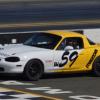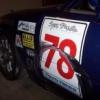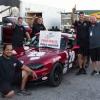I just installed a AEM wideband meter in my 1990 SM 1.6. It has a fuel pressure regulator. What Ratio should I be aiming to achieve?

Air to Fuel Ratio
#1

 Posted 10-16-2015 11:39 AM
Posted 10-16-2015 11:39 AM

#2

 Posted 10-16-2015 01:54 PM
Posted 10-16-2015 01:54 PM

Your answer will vary depending on what you are trying to achieve. And at what point on the curve you want(rpm)to measure.
Ron
RAmotorsports


#3

 Posted 10-16-2015 02:03 PM
Posted 10-16-2015 02:03 PM

#4

 Posted 10-16-2015 02:31 PM
Posted 10-16-2015 02:31 PM

Then you have a ball park when you're on track, assuming you can look at the gauge on track at the same time.
Maybe check Video after the session if you can't ?
J~








#5

 Posted 10-16-2015 03:42 PM
Posted 10-16-2015 03:42 PM

On typical street gas with some ethanol, assuming your sensor is near the front and not subject to exhaust leaks, you will probably find that the best you can do is too lean (14:1) at 5k richening up to too rich (<12:1) by 7k. Even with an adjusted AFM, rotating it and adjusting fuel pressure the adjustability is coarse at best. "Best" depends on what you want but assuming you prefer max useable power on the track then adjust (along with timing) for peak HP then start adding fuel to strengthen the 5-6k without suffering too much 6-7k. If you don't have access to a dyno and your gauge is good, start around 12.5:1 at 6k and then watch the numbers at 5k and 7k to make sure they aren't too far off.


#6

 Posted 10-16-2015 04:13 PM
Posted 10-16-2015 04:13 PM

Around 12.8-13.2 across the sweet spot (6250-7000), I try to keep mine around 12.7-12.8 for a bit more torque.
But like Johnny said, you have to spend time on the dyno, it is worth the time and money.
Few tips:
1. Consistency. Make sure your water temp is the same on each pull, and airflow/fans to the engine are the same on each pull. You want to accurately tell what differences your adjustments are making, not outside variables.
2. Look at the entire usable rpm range (~5800-7100) and see what adjustments lift the entire curve up. For the most part do not focus on peak numbers. Also look at the graph to determine what the most effective shift point is for your car to stay in the power curve.
3. Adjusting the AFM and FPR will do different things to your A/F curve in different places, mess around with both.
4. Adjust your spark timing. People say it is a red herring but it simply is not. I went outside of the usual number and found 2 ft/lbs across the entire curve (you do not need to exceed 15-16 degrees at idle, I run less)
Good luck!
- Alberto likes this
-Ecobrap


#7

 Posted 10-16-2015 04:14 PM
Posted 10-16-2015 04:14 PM

Where are you?
Edmond Oklahoma








#8

 Posted 10-16-2015 06:17 PM
Posted 10-16-2015 06:17 PM

As a non-expert, I really shouldn't say anything about this... but I'm not sure that finding the 'right' setting is as simple as just hitting a number on the dyno. I was really surprised how much that mechanical flapper door bounces around on track, and how much variation it causes in your otherwise perfectly tuned A/F ratio as you go around corners and up and down hills. I use a datalogger to track this stuff, and even then I have a hard time deciding what the optimum tune is (between FP, AFM tilt, flapper door spring clicks, etc.). Best of luck!

#9

 Posted 10-16-2015 06:27 PM
Posted 10-16-2015 06:27 PM

#10

 Posted 10-16-2015 10:07 PM
Posted 10-16-2015 10:07 PM

Around 12.8-13.2 across the sweet spot (6250-7000), I try to keep mine around 12.7-12.8 for a bit more torque.
But like Johnny said, you have to spend time on the dyno, it is worth the time and money.
Few tips:
1. Do your pulls in 3rd gear instead of 4th so that the dyno doesn't beat up the motor too much, you will still get good data.
2. Adjusting the AFM and FPR will do different things to your A/F curve in different places, mess around with both.
3. Adjust your spark timing. People say it is a red herring but it simply is not. I went outside of the usual number and found 2 ft/lbs across the entire curve (you do not need to exceed 15-16 degrees at idle, I run less)
4. Consistency. Make sure your water temp is the same on each pull, and airflow/fans to the engine are the same on each pull. You want to accurately tell what differences your adjustments are making, not outside variables.
5. Look at the entire usable rpm range (~5800-7100) and see what adjustments lift the entire curve up. For the most part do not focus on peak numbers. Also look at the graph to determine what the most effective shift point is for your car to stay in the power curve.
Good luck!
Couple hours at the dyno and your an expert
1 to 1 is what most agree cars should be dynoed at I believe...that is 4th gear in a Miata...
Ron
RAmotorsports


#11

 Posted 10-16-2015 11:19 PM
Posted 10-16-2015 11:19 PM

- Steve Scheifler likes this
3 podium finishes
2 2013 NASA nats
1 2013 Scca runoffs







#12

 Posted 10-17-2015 05:47 AM
Posted 10-17-2015 05:47 AM

#13

 Posted 10-17-2015 08:31 AM
Posted 10-17-2015 08:31 AM

#14

 Posted 10-17-2015 10:23 AM
Posted 10-17-2015 10:23 AM

3 podium finishes
2 2013 NASA nats
1 2013 Scca runoffs







#15

 Posted 10-17-2015 11:14 AM
Posted 10-17-2015 11:14 AM

#16

 Posted 10-17-2015 11:26 AM
Posted 10-17-2015 11:26 AM



#17

 Posted 10-17-2015 11:54 AM
Posted 10-17-2015 11:54 AM

3 podium finishes
2 2013 NASA nats
1 2013 Scca runoffs







#18

 Posted 10-17-2015 11:54 AM
Posted 10-17-2015 11:54 AM

#19

 Posted 10-17-2015 11:55 AM
Posted 10-17-2015 11:55 AM

3 podium finishes
2 2013 NASA nats
1 2013 Scca runoffs







#20

 Posted 10-17-2015 01:34 PM
Posted 10-17-2015 01:34 PM

Lol, the gear used on the dyno was the least important part of my post. I went back and edited it so that the numbers now actually represent how important each tip was.
IMO if I can get good data in 3rd, why would I use 4th? Shouldn't the engine perform the same at a given rpm regardless of load? More power is more power? I have seen no difference in A/F on the track (flapper door aside) than I did with my third gear pulls on the dyno. My justification was simply time pulling, it adds up, especially bouncing off the rev limiter which I rarely do at the track.
Couple hours at the dyno and your an expert
1 to 1 is what most agree cars should be dynoed at I believe...that is 4th gear in a Miata...
I'm not an expert, but I did learn from one! I am a sponge ![]()
-Ecobrap


0 user(s) are reading this topic
0 members, 0 guests, 0 anonymous users




 Sign In
Sign In Create Account
Create Account



 Back to top
Back to top Report
Report






